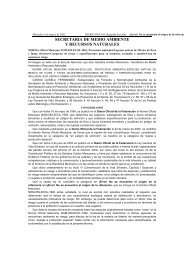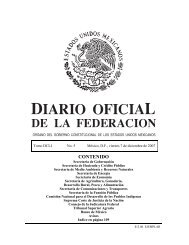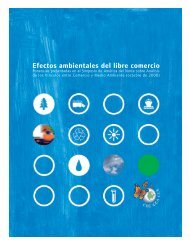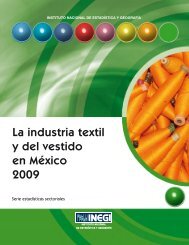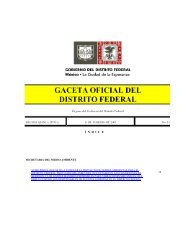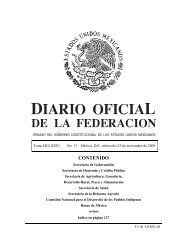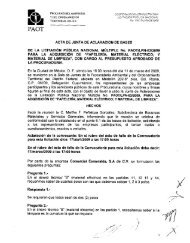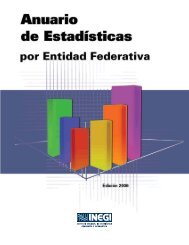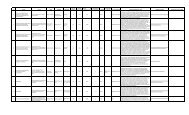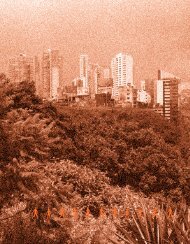- Page 1 and 2:
INSTITUTO NACIONAL DE ESTADÍSTICA
- Page 3 and 4:
PresentaciónEl Instituto Nacional
- Page 5 and 6:
Instituciones que proporcionaron in
- Page 7 and 8:
Índice generalIntroducciónResumen
- Page 9 and 10:
Entre los objetivos específicos qu
- Page 11 and 12:
Resumen2008 y 2009Cifras al cierre
- Page 13 and 14:
1. Importancia económica1.1 Valor
- Page 15 and 16:
Valor agregado bruto en valores bá
- Page 17 and 18:
Estructura del valor agregado bruto
- Page 19 and 20:
Valor agregado bruto total, de la i
- Page 21 and 22:
Participación del valor agregado b
- Page 23 and 24:
Índice de precios implícitos del
- Page 25 and 26:
Consumo intermedio total, de la ind
- Page 27 and 28:
Valor agregado bruto de la industri
- Page 29 and 30:
Consumo intermedio de la industria
- Page 31 and 32:
Remuneración media anual de la ind
- Page 33 and 34:
2.1.9 Consumo intermedio de la indu
- Page 35 and 36: 2.2 Producción de fibras2.2.1 Prod
- Page 37 and 38: 2.1 Cuentas económicas y de empleo
- Page 39 and 40: Estructura del valor agregado bruto
- Page 41 and 42: Índice de precios implícitos del
- Page 43 and 44: Cuenta de producción de la industr
- Page 45 and 46: Consumo intermedio de la industria
- Page 47 and 48: Remuneración media anual de la ind
- Page 49 and 50: Salarios mínimos profesionales en
- Page 51 and 52: Valor agregado bruto de la industri
- Page 53 and 54: Remuneraciones de la industria maqu
- Page 55 and 56: Resumen de las principales caracter
- Page 57 and 58: Principales características de la
- Page 59 and 60: Principales características de la
- Page 61 and 62: Principales características de la
- Page 63 and 64: Principales características de la
- Page 65 and 66: Principales características de la
- Page 67 and 68: Formación bruta de capital fijo de
- Page 69 and 70: Principales características de la
- Page 71 and 72: Principales características de la
- Page 73 and 74: Principales características de la
- Page 75 and 76: Principales características de la
- Page 77 and 78: Personal ocupado en la industria te
- Page 79 and 80: Remuneraciones totales al personal
- Page 81 and 82: Personal ocupado en la industria te
- Page 83 and 84: Horas trabajadas en la industria te
- Page 85: Remuneraciones totales en la indust
- Page 89 and 90: Personal ocupado total de la indust
- Page 91 and 92: Estructura del personal ocupado de
- Page 93 and 94: Valor agregado de la industria maqu
- Page 95 and 96: Personal ocupado en la industria ma
- Page 97 and 98: Remuneraciones pagadas al personal
- Page 99 and 100: Horas trabajadas en la industria ma
- Page 101 and 102: 3. Comercialización3.1 Ventas tota
- Page 103 and 104: 3.2.21 Valor de la exportación de
- Page 105 and 106: 3.3.12 Valor de la importación de
- Page 107 and 108: 3.4.2 Valor de la importación de m
- Page 109 and 110: 3.1 Ventas totales3.1.1 Mercado int
- Page 111 and 112: Volumen y valor de la exportación
- Page 113 and 114: Volumen y valor de la exportación
- Page 115 and 116: Volumen y valor de la exportación
- Page 117 and 118: Volumen y valor de la exportación
- Page 119 and 120: Volumen y valor de la exportación
- Page 121 and 122: Valor de la exportación de las dem
- Page 123 and 124: Valor de la exportación de alfombr
- Page 125 and 126: Valor de la exportación de telas i
- Page 127 and 128: Valor de la exportación de prendas
- Page 129 and 130: Valor de la exportación de prendas
- Page 131 and 132: Valor de la exportación de los dem
- Page 133 and 134: Volumen y valor de la importación
- Page 135 and 136: Volumen y valor de la importación
- Page 137 and 138:
Valor de la importación de hilados
- Page 139 and 140:
Valor de la importación de fibras
- Page 141 and 142:
Valor de la importación de las dem
- Page 143 and 144:
Valor de la importación de alfombr
- Page 145 and 146:
Valor de la importación de telas i
- Page 147 and 148:
Valor de la importación de tejidos
- Page 149 and 150:
Valor de la importación de prendas
- Page 151 and 152:
Valor de la importación de prendas
- Page 153 and 154:
Valor de la importación de los dem
- Page 155 and 156:
Valor de la importación de máquin
- Page 157 and 158:
Valor de la importación de máquin
- Page 159 and 160:
3.5 Consumo de productos textilesCo
- Page 161 and 162:
Índice de precios de materias prim
- Page 163 and 164:
4. Información financiera4.1 Créd
- Page 165 and 166:
4.1 CréditosCrédito bancario otor
- Page 167 and 168:
Crédito bancario otorgado a travé
- Page 169 and 170:
Distribucion de créditos bancarios
- Page 171 and 172:
4.2 InversiónValor de la inversió
- Page 173 and 174:
Valor de la inversión extranjera e
- Page 175 and 176:
Información financiera de CYDSASA
- Page 177 and 178:
Información financiera de GEASA Cu
- Page 179 and 180:
Información financiera de PARRAS C
- Page 181 and 182:
5. Comparaciones internacionales5.1
- Page 183 and 184:
5.2.7 Volumen de la exportación mu
- Page 185 and 186:
Producción de cordeles por países
- Page 187 and 188:
Producción de blusas para damas y
- Page 189 and 190:
Producción de ropa interior para c
- Page 191 and 192:
5.2 Comercio mundial de fibras text
- Page 193 and 194:
Volumen de la exportación mundial
- Page 195 and 196:
Volumen de la exportación mundial
- Page 197 and 198:
Volumen de la exportación mundial
- Page 199 and 200:
Volumen de la exportación mundial
- Page 201 and 202:
Volumen de la exportación mundial
- Page 203 and 204:
GlosarioAAlgodón. Fibra natural ob



